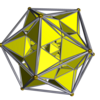Semiregular polytope
 Rectified 5-cell |
 Snub 24-cell |
 Rectified 600-cell |
In geometry, by Thorold Gosset's definition a semiregular polytope is usually taken to be a polytope that is vertex-uniform and has all its facets being regular polytopes.
In three-dimensional space and below, the terms semiregular polytope and uniform polytope have identical meanings, because all uniform polygons must be regular. However, since not all uniform polyhedra are regular, the number of semiregular polytopes in dimensions higher than three is much smaller than the number of uniform polytopes in the same number of dimensions.
The three convex semiregular polychora (4-polytopes) are the rectified 5-cell, snub 24-cell and rectified 600-cell. The only semiregular polytopes in higher dimensions are the k21 polytopes, where the rectified 5-cell is the special case of k = 0.
Semiregular polytopes can be extended to semiregular honeycombs. The semiregular Euclidean honeycombs are the tetrahedral-octahedral honeycomb (3D), gyrated alternated cubic honeycomb (3D) and the 521 honeycomb (8D).
Gosset's list
Semiregular figures Gosset enumerated: (his names in parentheses)
- Convex uniform honeycombs, two 3D honeycombs:
- Tetrahedral-octahedral honeycomb (Simple tetroctahedric check)
- Gyrated alternated cubic honeycomb (Complex tetroctahedric check)
- Uniform polychora, three 4-polytopes:
- Rectified 5-cell (Tetroctahedric)
- Snub 24-cell (Tetricosahedric)
- Rectified 600-cell (Octicosahedric)
- Semiregular E-polytopes, four polytopes, and one honeycomb:
- 5-demicube (5-ic semi-regular), a 5-polytope
- 221 polytope (6-ic semi-regular), a 6-polytope
- 321 polytope (7-ic semi-regular), a 7-polytope
- 421 polytope (8-ic semi-regular), an 8-polytope
- 521 honeycomb (9-ic check) (8D honeycomb)
See also
References
- Coxeter, H. S. M. (1973). Regular Polytopes ((3rd ed.) ed.). New York: Dover Publications. ISBN 0-486-61480-8.
- Gosset, Thorold (1900). "On the regular and semi-regular figures in space of n dimensions". Messenger of Mathematics. 29: 43–48.
